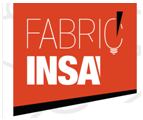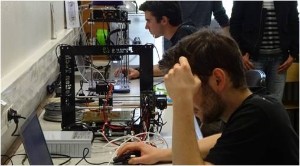Innovation
Innovative Events
The organization of two school-business-laboratory events:
- IoT day at INSA: more than 200 people involved in IoT will be present for seminars and practical workshop conducted by students, researchers and companies.
- 48hr Hackathons to imagine, create, and defend an innovative solution with coaching from industrialists and researchers.
One innovative project throughout the first semester to:
- Implement skills acquired over the first semester
- Take advantage of the multidisciplinary backgrounds of students
- Create an innovative prototype
- Use the tools provided by the Fablab at INSA
- Support from companies
Innovative evaluation through a portfolio
The ISS course has chosen to use skills-based assessment for different reasons:
- The diversity of students makes traditional forms of evaluation impractical
- To take into account the maturity and motivation of students
- The advantages of using a portfolio-based evaluation
The evaluation is based on a skills matrix that indicates both the skills required and, depending on the origin of the students, the required level and the assessment method. Innovation is incorporated into the MSIoT program not only through classwork but also in terms of evaluation. The portfolio is, in this context, a compilation of the work done by the learner which provides evidence of the skills and competences he/she has acquired. The student is encouraged to reflect and comment on their own work as part of a formative evaluation. In an evaluative portfolio, the focus is put not only on production as evidence, but also on the process followed by the student to achieve this production and the progress made through his work.
The portfolio can be an evaluation tool for learning even if it is not limited to this function. In a portfolio, there is an element of reflection because the student must analyze his own learning processes. It should also highlight and enhance his learning which, in general, is linked with "generic skills" (critical thinking, communication, computing, etc.). The portfolio requires autonomy and accountability. Within a framework defined by the teacher, the student actively participates in the creation of the document.
In terms of recommendations, since the focus is on production, the process and progress, work on the portfolio should start with teaching, and be added to continuously. It must be accompanied by regular feedback and must be implemented with a coherent schedule and precise instructions. Joint meetings are set up between a tutoring team and students to discuss and offer advice on the drafting of the portfolio. This concludes with a general presentation before a jury of their portfolio and more specifically an analysis of their skills acquired during the year. After, some students publish their portfolio online to be used as an explanatory tool for their degree course for future employers. These portfolio deal with the kernel modules of MSIoT called Innovative Smart System - ISS:
- Rémy Tribhout's Portfolio: http://etud.insa-toulouse.fr/~tribhout/
- Gabriel Mabille's Portfolio: http://etud.insa-toulouse.fr/~mabille/PortfeuilleCompetences
Finally, an interdisciplinary jury was set up to assess the students’ transversal project, which is conducted in English. The jury was composed of: Industrialists (Orange, CNES, etc.), representatives from local authorities (Toulouse Metropolis), incubators (Capital High Tech, ESA BIC, etc.), teachers / researchers from participating schools (INSA, ISIS, etc.).
 Fabric'INSA, the fablab of INSA TOULOUSE
Fabric'INSA, the fablab of INSA TOULOUSE
Our motto: discover, test, manufacture ... innovate together!
![]()
Created in March 2015, Fabric'INSA is a place where students can both manufacture objects and share knowledge. With its friendly, collaborative atmosphere, Fabric'INSA encourages students to express their creativity and their ideas and to bring them to life through computer-controlled machines. Self-manufactured objects (DIY) are our specialty.
Fabric'INSA is open to students and faculty to produce tangible objects for teaching or research.

All types of projects can be carried out, be they pedagogical, personal, or professional.

Users, with the help of other students, faculty, and the INSA community, can:
Prototype using a 3D printer, electronic tools, a traditional workshop, a wood shop, and many other tools.
Manufacture models and made-to-order objects, either individually or in small batches
Customize objects and make signs, including engraved Plexi-plates, wood cut letters, etc.
Learn thanks to course on how to use a 3D printer, to model in 3D, etc.
Meet people with different backgrounds & skills including engineers, programmers, designers, graphic artists, etc.


